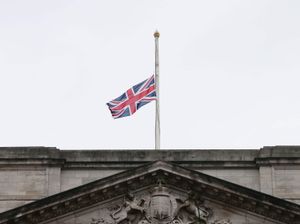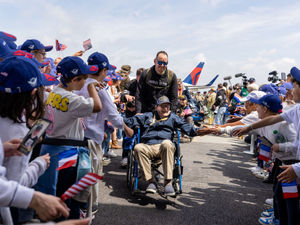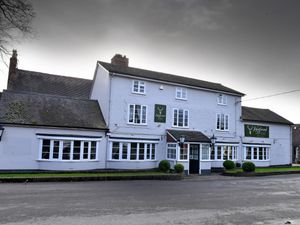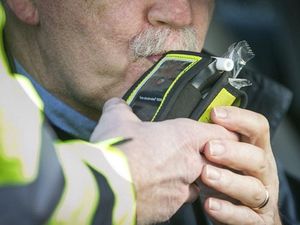Death of the Duke of Edinburgh – What happens now?
Funeral plans – codenamed Forth Bridge – will be put into action.

The Duke of Edinburgh has died. What happens next?
There will be no lying in state and no state funeral for Philip, in accordance with his wishes.
His ceremonial royal funeral and burial are expected to take place in St George’s Chapel at Windsor Castle.

But the coronavirus pandemic – with the ban on mass gatherings and England in national lockdown – means the exact plans for the aftermath of Philip’s death have had to change.
Buckingham Palace will confirm the arrangements for the duke’s funeral in the next day or so.
Here is a look at the events which might take place over the coming eight days:
– Forth Bridge
The Lord Chamberlain will finalise the long-held master plan – codenamed Forth Bridge – for the duke’s funeral and the days leading up to it with the Queen and set in motion the carefully orchestrated programme of events.
Philip helped draw up the details himself and was determined there should be a minimum of fuss.
Behind the scenes, aides and household staff will already have a contingency plan for use during the coronavirus outbreak, but will be busy adjusting it in line with current advice.
– Tributes and flowers
Tributes will flood in from around the world from presidents, prime ministers, heads of state, foreign royals, charities and the military.
Members of the public usually leave flowers at the gates of Buckingham Palace.

At some point, there will be gun salutes in the duke’s honour – if the military are able to facilitate this.
– Flags
Union flags on royal buildings where the monarch is not in residence will fly at half-mast.
The Royal Standard never flies at half-mast because it represents the sovereign and the United Kingdom, and is a symbol of the continuation of the monarchy.

If the Queen is in residence at a royal palace or castle, the Royal Standard will fly there full-mast as is the tradition.
The Union flag does not fly there at the same time.
The Union flag will fly at half-mast over the Houses of Parliament and other key sites.
The Department for Digital, Culture, Media and Sport is in charge of lowering flags on government buildings.
– Royal Family’s Mourning
The Queen has to decide whether the royal family enters Court Mourning – dressing in black and using black-edged writing paper – or the alternative, shorter Family Mourning – dressing in black – and how long this will last.

Some official engagements may continue, but social engagements – all on hold anyway because of the pandemic – are usually cancelled after the death of a senior member of the royal family unless in aid of charity.
Family Mourning for the Queen Mother in 2002 lasted three weeks.
– National Mourning
The Government decides on the length of any National Mourning.
A nationwide two-minute silence could take place, as it did for the Queen Mother on the day of her funeral.
– Parliament
Parliament is likely to honour the duke, with politicians gathering for special sessions in both the Commons and the Lords.
But arrangements will depend on what the Government is advising in terms of MPs socially distancing in Parliament.

– Queen may address the nation
The Queen may record a televised speech in tribute to her husband, just as she did for the Queen Mother in 2002, but it will depend on how she is feeling.
The rest of Philip’s family are likely to release their own statements about the royal patriarch.
The royal family’s website and social media channels will also honour the duke.
– Books of condolence
Books of condolence would usually be opened at certain royal residences, town halls across the country, and at British embassies around the world.
But this could lead to queues of people, which the Government will want to discourage.
It is likely online books of condolence will be set up to allow people to pay tribute.
– Television and media
Hundreds of journalists and broadcasters are still likely to descend on London and Windsor, leading to a mass gathering of reporters, photographers and television crews.

Scheduled programmes will be abandoned to pay tribute to the duke.
In the coming days, key events including the funeral will be expected to be televised live by the BBC and other broadcasters.
– Coffin at rest
Traditionally, the duke’s coffin would have been moved to the Chapel Royal at St James’s Palace to remain at rest for several days, but this is unlikely to be necessary if there is no longer a London element to the plans.
The Queen retreated to Windsor Castle for the lockdown period so events look set to be focused there instead.
The monarch and the royal family will pay their respects in private, as will household staff.
Philip’s children are likely to hold a private vigil at some stage around the coffin if restrictions permit.
– Behind the scenes
The duke’s funeral was due to have a strong military presence in recognition of his naval career and his links with the armed forces.
But the prospect of creating a spectacle that could potentially attract hundreds of thousands of people means there is no longer expected to be a military procession in London or any processions through Windsor.
A military involvement is expected to take place within the grounds of Windsor Castle.
Those servicemen and women taking part will rapidly begin their preparations, from practising routines to polishing helmets and swords.

Royal dressers will be fastidiously choosing and preparing black mourning ensembles.
The Metropolitan Police will be tasked with dealing with the security needed in the days ahead, and preventing mass gatherings.
– Lying in state
The duke’s coffin will not lie in state.
This has long been reported as the plan but, amid the Covid-19 pandemic, has the added benefit of freeing the Government and the Royal Household from a series of logistical nightmares.
The Queen Mother – the last sovereign’s consort to die – lay in state in Westminster Hall, allowing hundreds of thousands of people, who queued for hours, to file past to pay their respects.
But Philip always insisted he did not want this honour.

– Funeral
The duke’s funeral will not be a state funeral; instead it is set to be a ceremonial royal funeral.
This is in keeping with protocol. The Queen Mother was also given a ceremonial royal funeral.
The duke’s funeral is expected to take place at Windsor Castle’s St George’s Chapel eight days after his death.
Philip’s children and older grandchildren were likely to have walked behind the coffin, similar to the processions for the funerals of Diana, Princess of Wales, and the Queen Mother.

The televised funeral service – for which the order of service is already set – was originally planned for 800 guests, but will now have to take into account the strict limit on numbers during the pandemic.
At present, only 30 guests are allowed to attend a funeral in England.
The Queen will have to decide which family members to invite.
In the coming days, Buckingham Palace aides will confirm the finalised plans, with how they should be handled during the worst public health crisis for a generation at the forefront of their minds.
– Burial
The duke is expected to be buried in the Royal Vault in St George’s Chapel on the same day as the funeral.
This interment service will be private, attended by the Queen and senior members of the royal family.
– No memorial service
In accordance with Philip’s wishes, there will be no official memorial service.
This might change, however, because of the scaled-back funeral – but only with the Queen’s agreement.




